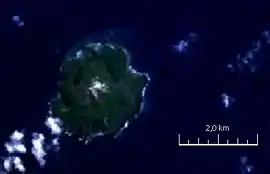Fonualei
Fonualei is an uninhabited 5 km2 volcanic island close to Vavaʻu in the kingdom of Tonga. It was seen by Don Francisco Mourelle de la Rua on the La Princesa on 26 February 1781.[2] He reported the island to be barren from eruptions, and called it for that reason Amargura (Bitterness in Spanish).
| Fonualei | |
|---|---|
 image of Fonualei Island, northern Tonga, Pacific Ocean | |
| Highest point | |
| Elevation | 180 m (590 ft) [1] |
| Listing | List of volcanoes in Tonga |
| Coordinates | 18.024°S 174.325°W |
| Geography | |
| Location | Tonga Islands |
| Geology | |
| Mountain type | Stratovolcano |
| Last eruption | June 1957 |
A major eruption in 1846, starting 11 June, destroyed much of the vegetation of Vavaʻu and spread ash around for at least a year. Some sources claim that three other neighbouring volcanoes, Late, Tokū and another, erupted at the same time. This is probably a mistake by passing ships who misidentified the erupting island.
The closest island to Fonualei is Tokū 19.7 km to the southeast.
See also
- List of volcanoes in Tonga
- List of islands
- Desert island
References
- "Fonualei". Global Volcanism Program. Smithsonian Institution. Retrieved 2010-02-27.
- Sharp, Andrew, The discovery of the Pacific Islands Oxford 1960, p.149
- D. Gerstle; Gentle people, into the heart of Vavaʻu 1781–1973; Tofua press 1973
- Dirk HR Spennemann, The June 1846 Eruption of Fonualei Volcano, Tonga. An Historical Analysis. The Johnstone Centre. Report Nº 196.
This article is issued from Wikipedia. The text is licensed under Creative Commons - Attribution - Sharealike. Additional terms may apply for the media files.
